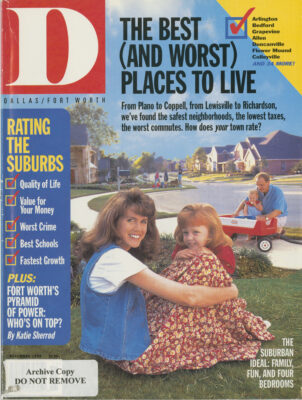Theater Row
THERE WERE NO 20-SCREEN megaplexes on Theater Row, no surround sound, not even cupholder armrests. But from the 1920s through the 1960s, the stretch of Elm Street from Harwood to Akard was the entertainment heart of the city.
During my own Age of Enlightenment, from the end of the Big War through the Korean truce at Panmunjom, I misspent many Saturdays along Theater Row. I’d meander along the north side of Elm Street, making critical assessments of the weekend offerings based upon the enticing glossy photos displayed under the shade of the marquees or the exaggerated claims of sidewalk barkers. Then, the terrain surveyed, I’d invest my weekly allowance.
The Majestic was the logical starting point. Opened in 1921 as a vaudeville house, this grand dame of the local Interstate chain featured first-class action pictures such as Red River and High Noon. On the downside were the exorbitant price-60 cents for patrons age 12 and over-and the stodgy ushers, who had no appreciation for funny remarks from the audience and zero tolerance for muffled snickering.
Next was the Melba, originally a vaudeville house called the Hope, which was just a cut below the Majestic in grandeur. Then came the graceful Tower, built in 1937 and featuring a mirrored foyer where teenagers could surreptitiously check their duck-tails. The block between St. Paul and Ervay streets had no theaters but featured cheap eats and a public restroom underground at the Elm/Live Oak triangle.
Across Ervay was the Palace, opened just two months after the Majestic, which had little appeal to the Saturday morning crowd. The Palace was famous for romance (with cute bits of fluff like Pillow Talk or sentimental opuses like Love in the Afternoon) and for the gigantic Wurlitzer and the organist in the white suit who rose together out of the floor during intermission.
The Rialto, the result of the 1935 remodeling of the Old Mill Theater that had burned, was a popular medium-priced hangout (35 cents), featuring re-runs of die Frankenstein epics, gangster movies, and Laurel and Hardy revivals. Next door was the 1922 vintage Capitol, where a double feature of Tex Ritter and Johnny Mack Brown cost 20 cents and an outdoor popcorn machine fed famished movie-goers who were trying to make a decision.
It was downhill from there- the Telenews, which had been the Jefferson and the Mirror, and which later tried valiantly to survive as the Dallas, featured nonstop newsreels. The Leo (the Queen in better times) concentrated on the burning social issues of the day, with such offerings as Reefer Madness and Mom & Dad, a heartbreaking tale of teenage pregnancy. Across Akard was the Fox, a run-down, ex-silent film emporium which came to rely on skin flicks featuring females in black lace underwear. Young gentlemen with keen eyesight could stand on the Leo side of Akard and look at the pictures on the wall of the Fox while pretending to wait for a bus.
By the late ’60s, the Fox, Leo, Telenews, Capitol, and Rialto had been replaced by office buildings; then the Tower closed and the Melba was converted to the Capri, an unsuccessful adventure in multi-screening. The Palace was torn down in 1970, and the Majestic closed in 1973, but this crown jewel of Dallas movie architecture was saved by a determined cadre of civic-minded patrons of the arts. Long live what’s left.
ELM STREET ECHOES
Live and on stage: In vaudeville reviews, personal appearances to promote movie premieres, or live performances, luminaries who have appeared on Elm Street stages include Harry Houdini, Eddie Cantor, George Jessel, Mae West, Bob Hope, Burns and Allen, John Wayne, Duke Ellington, Paul White-man, Jack Benny, Milton Berle, Liberace, Joan Crawford, Jimmy Stewart, Bette Davis, Gregory Peck, Spike Jones, Cab Calloway, and Fess Parker.
The Great White Way: Elm Street earned mis tag following the installation of 110 street lights in 1911.
Featured flapper Ginger Rogers broke into show business m 1926 by winning a Charleston contest at the Majestic.
In living color The first full-length color motion picture to play in Dallas was Becky Sharp at the Palace in 1955.
Scandal on Elm Street The Fox Theater shocked the city in the early 1930s by showing Ecstasy, a Czecho-slovakian film featuring Hedy Lamarr swimming nude.
Sinking sensation: In 1967, a large chunk of Elm Street caved in, leading to the year’s favorite bumper sticker: “Visit the Wondrous Elm Street Cave.”
The Bond connection: I ne all-time top-grossing film at the Majestic was Sean Connery’s Thunderball in 1965; the last film to play before the theater closed in 1973 was Live and Let Die with Roger Moore as James Bond.
Get our weekly recap
Brings new meaning to the phrase Sunday Funday. No spam, ever.
Related Articles

Arts & Entertainment
DIFF Documentary City of Hate Reframes JFK’s Assassination Alongside Modern Dallas
Documentarian Quin Mathews revisited the topic in the wake of a number of tragedies that shared North Texas as their center.
By Austin Zook

Business
How Plug and Play in Frisco and McKinney Is Connecting DFW to a Global Innovation Circuit
The global innovation platform headquartered in Silicon Valley has launched accelerator programs in North Texas focused on sports tech, fintech and AI.

Arts & Entertainment
‘The Trouble is You Think You Have Time’: Paul Levatino on Bastards of Soul
A Q&A with the music-industry veteran and first-time feature director about his new documentary and the loss of a friend.
By Zac Crain


